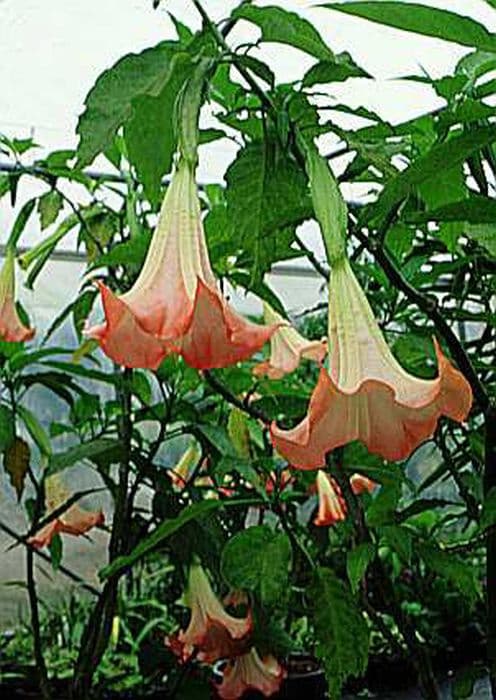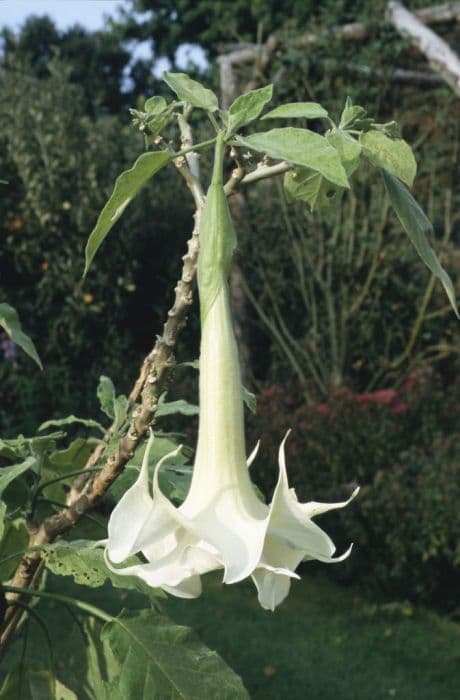Petunia Sanguna Blue Vein = 'Potliblue' (Sanguna Series)
![petunia [Sanguna Blue Vein]](/_next/image?url=https%3A%2F%2Fplants-admin.emdemapps.com%2Fimages%2Fplants%2F%2Fimages%2F604b5cbcdd657.png&w=3840&q=75)
ABOUT
The Petunia Sanguna Blue Vein is a vibrant and decorative flowering plant known for its striking blossoms and attractive foliage. The flowers of this variety are characterized by their rich blue color, which is boldly accented by a pattern of prominent blue veins that create a striking contrast against the lighter background of the petals. These blossoms are trumpet-shaped, a classic feature of petunias, and they often have a slightly ruffled or fringed edge which adds to their ornamental appeal. The plant itself has a lush, green growth habit that serves as a lovely backdrop for the profusion of colorful flowers. The leaves are typically smooth with slightly pointed ends and have a dark green hue that complements the blue tones of the blooms. This petunia variety blooms prolifically and consistently throughout its growing season, creating a long-lasting display of color and texture. The Petunia Sanguna Blue Vein is a popular choice for gardeners looking to add a splash of cool-toned color to their garden palettes. Its blossoms can also exude a subtle fragrance that can be especially noticeable in the early morning or evening, making it not only a visual delight but a sensory one as well.
About this plant
 Names
NamesFamily
Solanaceae
Synonyms
Petunia, Trailing Petunia
Common names
Petunia 'Potliblue'.
 Toxicity
ToxicityTo humans
Petunias are not considered toxic to humans. They are commonly grown in gardens and containers for their colorful blooms and do not pose a risk if touched or ingested in small amounts. However, ingestion of any plant material may cause discomfort or an allergic reaction in some people. If large amounts are ingested, it may lead to gastrointestinal upset, but this is not common due to the plant's lack of toxicity.
To pets
Petunias, including the Petunia Sanguna Blue Vein, are generally considered non-toxic to pets such as dogs and cats. They are widely used in ornamental gardening with no significant risk of poisoning if pets happen to ingest the leaves or flowers. Nonetheless, individual animals may have different sensitivities, and ingesting plant material can sometimes lead to mild gastrointestinal upset. If a pet consumes a large amount of the plant and exhibits symptoms of distress, it is recommended to consult a veterinarian.
 Characteristics
CharacteristicsLife cycle
Annuals
Foliage type
Deciduous
Color of leaves
Green
Flower color
Blue
Height
1 foot (30 cm)
Spread
1 foot (30 cm)
Plant type
Herb
Hardiness zones
10
Native area
South America
Benefits
 General Benefits
General Benefits- Attractive Blooms: Petunia Sanguna Blue Vein produces vibrant blue flowers with white veins, adding a striking visual impact to gardens or containers.
- Long Flowering Season: This plant typically blooms from late spring until the first frost, providing a long season of color.
- Easy to Grow: Petunias are known for being easy to care for, making them suitable for beginner gardeners.
- Drought Tolerant: Once established, petunias can tolerate periods of dryness, reducing the need for frequent watering.
- Versatile Planting Options: They can be planted in garden beds, containers, hanging baskets, and window boxes, providing flexibility in garden design.
- Attracts Pollinators: The blooms attract butterflies and hummingbirds, promoting a healthy and vibrant garden ecosystem.
- Rapid Growth: Petunias grow quickly and can fill in garden spaces, providing a lush look in a relatively short time frame.
- Low Maintenance: Apart from regular watering and the occasional feeding, petunias require little day-to-day care.
- Deadheading Not Required: Many modern petunia hybrids, including the 'Potliblue', do not require deadheading to promote continuous blooming.
 Medical Properties
Medical PropertiesThis plant is not used for medical purposes.
 Air-purifying Qualities
Air-purifying QualitiesThis plant is not specifically known for air purifying qualities.
 Other Uses
Other Uses- Photography Prop: Petunias can serve as a vibrant backdrop or subject for floral photography, allowing photographers to capture their intricate pattern and color.
- Educational Tool: Biology teachers can use petunias to demonstrate concepts of plant biology, hybridization, and genetics due to the plant's variety of colors.
- Craft Projects: Petunia flowers can be pressed and included in craft projects like making bookmarks, greeting cards, or decoupage art pieces.
- Perfume Inspiration: Although not directly used in perfumery, the fragrance of petunias can inspire scent profiles for perfumes and other scented products.
- Color Dye: Petunias have the potential to be used as a natural color dye for fabrics or art projects, by boiling the flowers to extract the color.
- Natural Confetti: Dried petals of petunias can be used as biodegradable confetti for outdoor celebrations or events.
- Floral Arrangements: Petunias can be used creatively in non-traditional floral arrangements, such as submerged centerpieces for events.
- Sand Art: Colored sand art projects can incorporate petunia petals for added texture and bursts of color between the layers of sand.
- Writing Ink: The vibrant pigments from petunia petals might be used to create natural inks for writing or drawing.
- Culinary Garnish: Although not a common practice, petunia flowers are edible and can be used as an ornamental garnish to add color to salads and desserts.
Interesting Facts
 Feng Shui
Feng ShuiThe Petunia is not used in Feng Shui practice.
 Zodiac Sign Compitability
Zodiac Sign CompitabilityThe Petunia is not used in astrology practice.
 Plant Symbolism
Plant Symbolism- Anger and Resentment: In Victorian flower language, petunias can represent feelings of anger and resentment, possibly because they tend to bloom with overwhelming prolificacy, which might be seen as intrusive.
- Soothing Presence: The color blue generally symbolizes peace and tranquility. The 'Potliblue' variety, with its calming blue veins, may symbolize a soothing presence in one's life.
- Desire to Spend Time Together: Offering a petunia to someone can be a way to express the desire to be with that person because petunias are companionable plants that can grow well with others.
 Water
WaterPetunias require regular watering, ideally providing them with about 1 inch of water per week. A good method is to check the soil moisture with your finger; if the top inch is dry, it's time to water. During hot weather, you may need to water the petunias more frequently, possibly every other day. It's important to water at the base of the plant to avoid wetting the foliage, which can lead to fungal diseases. For container-grown petunias, ensure there's adequate drainage and they may require daily watering since pots can dry out quickly.
 Light
LightPetunias thrive in full sunlight, making them ideal for a spot that receives at least 6 to 8 hours of direct sun per day. They can tolerate partial shade, especially in hotter regions, but they bloom best with ample sunshine. Balconies, patios, or garden beds that are exposed to full sun are the best locations for petunias to flourish.
 Temperature
TemperaturePetunias prefer warm temperatures and perform best when daytime temperatures are between 60 and 85 degrees Fahrenheit. They can handle occasional dips at night down to about 40 degrees Fahrenheit but frost can severely damage or kill them. Consistently maintaining temperatures within this range will promote vigorous growth and flowering.
 Pruning
PruningPruning petunias is necessary to promote bushier growth and prevent legginess. Pinch back the stems every few weeks, especially when the plant starts to look stretched. Deadheading, or removing spent flowers, will also encourage more blooms. The best time to prune and deadhead petunias is during the morning, allowing the plant to heal throughout the day.
 Cleaning
CleaningAs needed
 Soil
SoilPetunias prefer a well-draining, fertile soil mix with a slightly acidic to neutral pH range of 5.6 to 7.5. An ideal mix for Petunias would include peat moss, compost, perlite, and vermiculite to ensure good aeration and moisture retention. Regular feeding with a balanced fertilizer will support their vigorous growth and blooming.
 Repotting
RepottingPetunias generally do not require frequent repotting and are often grown as annuals. However, if grown as perennials or when kept in containers, they should be repotted every spring to refresh the soil and to accommodate root growth.
 Humidity & Misting
Humidity & MistingPetunias thrive in moderate humidity levels that are typical of outdoor conditions. They do not require high humidity and can tolerate the dry air found in most home environments. Consistency is key rather than high humidity levels.
 Suitable locations
Suitable locationsIndoor
Provide bright sunlight and well-draining soil.
Outdoor
Full sun, fertile soil, and regular watering.
Hardiness zone
9-11 USDA
 Life cycle
Life cycleThe life cycle of the Petunia Sanguna Blue Vein begins with germination, where the seed absorbs water and emerges from the soil. Following germination, the seedling stage is characterized by the growth of primary leaves and root establishment. As the plant enters the vegetative stage, it develops a robust root system, foliage, and stems but does not yet flower. The flowering stage follows, during which 'Potliblue' petunias produce their distinctive blue-veined blossoms, attracting pollinators and setting seed. After pollination, the plant produces seeds during the reproductive stage, which can be collected for future propagation. The plant eventually reaches senescence, where growth slow,s and the plant may die, completing its life cycle.
 Propogation
PropogationPropogation time
Spring to Summer
Propogation: The Petunia Sanguna Blue Vein, commonly known as simply "Petunia", is typically propagated through cuttings. The most popular method involves selecting a healthy, non-flowering shoot and trimming it to about 3 to 4 inches (roughly 7.5 to 10 centimeters) in length. The cut end of the shoot is then dipped into a rooting hormone to encourage root growth and planted in a moist, well-draining potting mix. The cutting should be kept in a warm, bright location out of direct sunlight to avoid scorching the tender new growth. It's important to maintain humidity around the cutting, often by covering it with a plastic bag or placing it in a propagator, until roots have established, which usually takes a few weeks. Once rooted, the young Petunia plants can be transplanted into individual pots and gradually acclimatized to outdoor conditions before planting out.


![Calibrachoa [Aloha Classic Blue Sky]](/_next/image?url=https%3A%2F%2Fplants-admin.emdemapps.com%2Fimages%2Fplants%2F%2Fimages%2F604b636c3778b.png&w=640&q=75)
![Calibrachoa [Aloha Classic Gold]](/_next/image?url=https%3A%2F%2Fplants-admin.emdemapps.com%2Fimages%2Fplants%2F%2Fimages%2F604b6284c573e.png&w=640&q=75)
![Calibrachoa [Aloha Classic Tiki Soft Pink]](/_next/image?url=https%3A%2F%2Fplants-admin.emdemapps.com%2Fimages%2Fplants%2F%2Fimages%2F604b548e0a5ef.png&w=640&q=75)
![Calibrachoa [Cabaret Deep Yellow]](/_next/image?url=https%3A%2F%2Fplants-admin.emdemapps.com%2Fimages%2Fplants%2F%2Fimages%2F604b5f20ca3ef.png&w=640&q=75)
![Calibrachoa [Calibasket Radiant Orange]](/_next/image?url=https%3A%2F%2Fplants-admin.emdemapps.com%2Fimages%2Fplants%2F%2Fimages%2F604b536d43cb2.png&w=640&q=75)
![Calibrachoa [Caloha Classic Blue Velvet]](/_next/image?url=https%3A%2F%2Fplants-admin.emdemapps.com%2Fimages%2Fplants%2F%2Fimages%2F604b604884a75.png&w=640&q=75)
![Calibrachoa [Caloha Classic Honey White]](/_next/image?url=https%3A%2F%2Fplants-admin.emdemapps.com%2Fimages%2Fplants%2F%2Fimages%2F604b5f56e0beb.png&w=640&q=75)
![Calibrachoa [Caloha Classic Yellow Chocolate Ring]](/_next/image?url=https%3A%2F%2Fplants-admin.emdemapps.com%2Fimages%2Fplants%2F%2Fimages%2F604b538aede95.png&w=640&q=75)